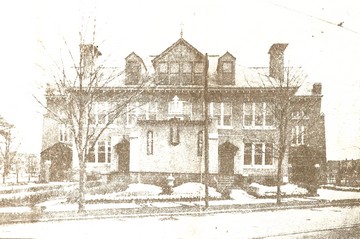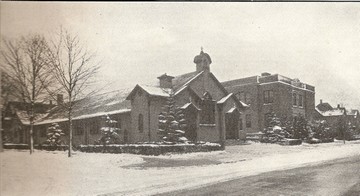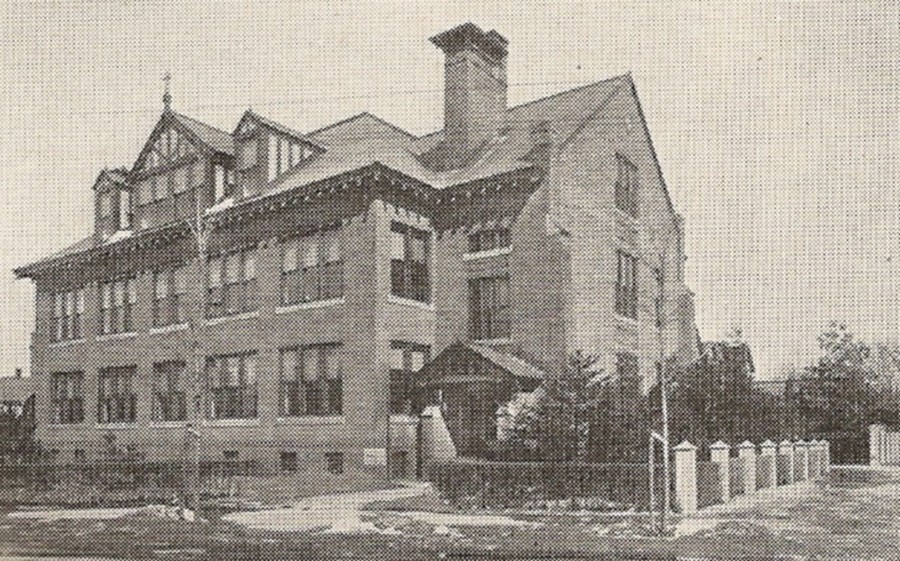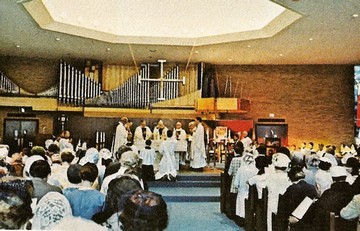The following history was published in conjunction with Holy Name’s centennial in 2009.

In the early years of the 20th century, the population of the Forest Park area of Springfield was rapidly growing. Bishop Thomas D. Beaven, Bishop of the Diocese of Springfield from 1851-1920, realized that a new parish would be necessary to minister to the needs of a growing population. The diocese purchased the land on Dickinson Street near the “X” between Grenada Terrace and Alderman Street to form what would become the Holy Name of Jesus complex.
On January 1, 1909 it was announced that Fr. Thomas A. McGovern would be the new pastor of Holy Name Church. Fr. McGovern rented a house at the corner of Oakland and Dickinson Streets, diagonally across from the present fire station. This was to serve as a rectory, while the gym at Forest Park School made a suitable place to say Mass. Soon, the first baby girl, Mary Clark Beele, and the first baby boy, Daniel Walsh, Jr, were baptized. Groundbreaking for the church/school began on April 1, 1909 and on December 8, 1909 a chapel was ready. On January 16, 1910, Bishop Beaven dedicated and blessed the new chapel. In the fall of 1910, in the same building, Fr. McGovern started Holy Name School, consisting of four grades with an enrollment of 200 children. Five Sisters of St. Joseph traveled each day via streetcar from their Motherhouse on Elliot Street until their convent on Berendo Street was purchased. In 1910, a large house on the corner of Dickinson and Alderman Streets was purchased to serve as the rectory, a function the building still holds today.


The congregation soon outgrew the chapel. Fr. McGovern consulted with the Bishop, outlining his plans for a Spanish mission style church to seat about 800 and to cost around $20,000. The Bishop consented and the land at the corner of Alderman and Berendo streets was purchased for $1500. On June 26, 1916, he publicly announced his plans. Work began in August and the building was complete on May 29, 1917.
In 1919, World War I was over and many of Holy Name’s young men returned home. The parish had more than doubled in its first ten years and more living space for the parish priests were needed. The house at 19 Alderman Street was purchased on March 8, 1920 and work was started to connect that building to the rectory and the entire unit was finished in stucco. On April 27th the lot for the second school building was acquired. Ground was broken for that building in 1924 and was first used for the school in September 1926. During the next several years, the first floor was used for classrooms, with the second floors serving as an auditorium, social hall, and in later years, a place for Sunday Masses.
On January 1, 1934, Holy Name celebrated its 25th anniversary, and Fr. McGovern his 40th as a priest. The parish had grown to 8300 souls in that time, and with the need for more curates and a place to house them, the dwelling at 329 Dickinson Street was purchased and connected to the existing rectory.
Fr. McGovern passed away April 28, 1937. Fr. George S.L. Connor was named the second pastor of Holy Name on August 1, 1937. With the coming of Father George S.L. (as everyone referred to him), Holy Name Parish became very active and socially oriented, with the formation of Candlepin Bowling Leagues, Communion Breakfasts, Card Parties, Sports Nights, Bake Sales, Afternoon Teas, plus Men and Women’s Social Clubs. In 1938, he announced plans to enlarge the Church by adding a row of pews on each side, bringing seating capacity to about 1400. The completed church was rededicated on November 13, 1938.
During World War II, many of Holy Name’s young men were called to serve. There was a feverish attempt on the part of those who remained at home to bolster their spirits. Every group in the parish took part in raising money, buying bonds and participating in many other affairs to entertain them while they were home on furlough. After the war, a big “Welcome Home” party was sponsored by the Holy Name MOMS (Mothers of Militant Sons).
Sadly, 1948 is to be remembered for an attempt to burn down Holy Name Church. After the July 14th fire, the church was closed for some time until repairs to the charred areas could be made. That year, Fr. Connor also announced the building of the Holy Name Social Center. Five houses on Berendo Street were moved to make way for the new building.
In 1949, with the parish numbering more than 10,000 people and crowding the masses in both the church and the hall, Bishop O’Leary and Fr. Connor decided to start a new parish which would be made up of a portion of Holy Name, Holy Family, and Our Lady of the Sacred Heart parishes and would be known as Holy Cross Parish. Because many who would become members of the new parish had contributed to the Holy Name building fund, Fr. Connor decided it was only proper to turn over a sizable sum to purchase the land for the new church.
The Social Center was dedicated on May 13, 1951. The dedication ceremonies were held with hundreds of church and civic dignitaries in attendance, followed by an “open house.” Fr. Connor appointed Paul Smith and his wife Ella (Walsh) to take over operation of the Social Center. It was during this time that the parking lot was paved as well. Ed Larkin, who ran the construction company responsible for this project, was not overly concerned with the trees. However, his daughter Barbara Larkin, who also served as a part-time organist for the parish, started a passionate campaign to save one special tree which has stood ever since in the middle of the parking lot.
On June 12, 1960 Father (now Monsignor) Connor announced that once again a new parish was being formed. This time 1100 people from Holy Name would be joined with 500 people from St. Michael’s in East Longmeadow to form St. Paul’s Parish on Dwight Road. As was the case when Holy Cross was established, Msgr. Connor donated a sizable sum with which to purchase the land for the church and rectory as Holy Name’s way of saying “thank you” for their contributions to Holy Name’s building fund. The first mass at St. Paul’s was celebrated on September 8, 1963.
On June 26, 1962, Msgr. George S.L. Connor died while visiting friends. As he was in good health, this came as a great shock to the parish. A few months later, Msgr. Walter C. Connell was named the third pastor of Holy Name. As he was a former Holy Name School student, this announcement was met with great joy, especially by those who had known him since childhood. He was the son of George and Margaret Connell, original members of Holy Name Parish.
On March 31, 1967, Msgr. Connell announced that architect’s plans for a new parish church had been accepted by him and approved by Bishop Weldon. Before construction, however, there had to be destruction. Since the old convent, which housed the Sisters of St. Joseph who staffed the parish school, was on the site for the new church, it had to be demolished. On May 22, 1967, demolition began. As cheering students from the parish school watched, their principal, Sister Patricia Maria, SSJ and Msgr. Connell took turns wielding a symbolic wrecking bar to signal the start of the waiting bulldozers. On June 6, 1967 ground was broken for the new building.

On August 4, 1968, the church doors were opened for the full Sunday Mass schedule. Seven children were also baptized that day. Saturday August 11th marked two more “firsts” for the new church. The first funeral was for Mrs. Joseph LaValley and the first wedding was for Patricia O’Shaughnessey and Edward Borucki. The official dedication ceremony for the new church was held September 8, 1968 and was very well-attended.
With the cost of building the social center and the “dream” church, the parish had incurred a large mortgage. After meeting with members of the parish community, it was decided to start a weekly Bingo. Beginning in 1973, Tuesday night was “Bingo” night at Holy Name. In 1975, weekly prizes totaled more than $6000 with a gross income of $500,000 and a net to the parish of $140,000. At that time, Holy Name Bingo was the largest in the state.
In early 1974, Msgr. Connell became ill and was relieved of his duties as pastor. He would pass away one year later. Also in 1974, the first lay persons were accepted as Eucharistic Ministers. In January 1975, Fr. McNamara, a former curate at the parish, was back, this time as pastor.
In September 1978, led by Father Thomas Shea, a group of 17 people began the Forever Young Club which was open to those age 50 and older. In August 1979, Fr. Warren Savage joined Holy Name as a curate becoming the first black priest to serve the parish. He would serve at Holy Name through June of 1983.
Because the parish was (and is) fortunate to have caring parents who volunteered to coach the various sports, Holy Name has had a long and proud athletic tradition. Over the years, there have been many different sports offered including football, baseball, basketball, soccer, gymnastics, and synchronized swimming. In the 1980s, the Holy Name Athletic Association was formed to organize and promote Holy Name athletics. The 1980s also saw the beginning of the annual Holy Name Craft Fair and some “sprucing up” of the Social Center which had started to show its age. The parish celebrated Fr. Mac’s 40th anniversary of priesthood in January of 1988.
From the very beginning, Holy Name has had a strong commitment to community service. There have been collections of food, items for shelters, educational materials for those in Appalachia, blood drives, the serving of meals at Loaves and Fishes, the making of quilts for babies in need, and working with Habitat for Humanity, to name just a few. In 1989, after many years of donating food to the Open Pantry, the parish began its own emergency food pantry to help those in the neighborhood. Parishioners continue to generously support this effort as well as many other charitable projects.
In 1989, Fr. McNamara stepped down and Fr. Lionel Bonneville became Holy Name’s fifth pastor. The parish was deeply saddened by Fr. McNamara’s death in 1990. 1990 also saw the social center opened on Fridays for “youth nights” geared to junior high and high school students. This would continue for three years. Also in 1990, a contemporary music group, “Wings of Praise,” formed and has shared their beautiful liturgical music with the parish ever since.
In July 1992, Holy Name welcomed Fr. Hugh Crean as pastor. He would serve until 1999. During his tenure, endowments were started for the church, school, and social center to help bolster their future financial stability. In 1993, Holy Name School started its first preschool class. Also that year, the parish welcomed a newly ordained Fr. Christoper Connelly to his first assignment. Fr. Connelly is now Msgr. Connelly and Vicar General for the Diocese of Springfield. In 1994, the Men’s Club sponsored the 1st Holy Name Hall of Fame dinner with Mr. Hopewell Budd as the first honoree. Girls were also welcomed as altar servers for the first time in 1994.
While a Vietnamese prayer group had begun at the parish in 1993, 1997 brought the Southeast Asian Apostolate under the leadership of Fr. Quynh Tran to Holy Name. Although not part of the parish per se, its members added much to the richness and diversity of our community.
Fr. Gerald Brady, who had served as a deacon at the parish, became pastor in 1999. Holy Name rang in the beginning of the year 2000 with a midnight mass to celebrate and pray for blessings upon the new century and the new millennium. Special masses were also held as the parish and school community gathered to mourn the tragic events of September 11, 2001. Fr. Brady became ill in 2001 and needed to step down as pastor. Fr. John Connors took over the helm as administrator. He became pastor in 2003. In 2002, after a hiatus of a few years, Bingo returned to the Social Center as a fundraiser to help support the school. In 2003, the Welcome Garden began, as did the 9:45 children’s mass which quickly became very popular with the parish community.
By 2007, the Southeast Asian Apostolate required more growing room than was available at Holy Name and the group subsequently moved to St. Paul’s Church. In 2008, the parish was once again in transition, with Fr. Connors stepping down. Fr. Mark Mengel, SSC was welcomed as the ninth pastor of Holy Name.
Throughout the past century, the lifeblood of the parish has been the parishioners themselves. While their names may not appear in the official history, the parish would not have thrived without the energy and selfless devotion of its members, from the earliest to those in the present day. Parishioners have offered their time, talent, and treasure in so many ways. They have taken part in stage productions at the Social Center in which they performed, sang, and played instruments. Under the auspices of the Spiritual Life Commission, they have sponsored the annual St. Jude Novena in the fall, as well as the blessings of athletes, of couples with special anniversaries, and of motorcycles. The Men’s Club has been instrumental in the parish for years, serving as ushers and hosting monthly pancake breakfasts, special dinners, and the annual children’s Christmas party among other events. The Family Life Commission sponsors the family picnics at Heritage Park and the annual parish dinner in the fall.
The Community Life Commission is the charitable outreach of the parish. They coordinate serving meals at “Loaves and Fishes” and collections for local shelters. They also sponsor the Thanksgiving food drive, the parish food pantry, and the “back to school” drive for students in Kentucky. Parishioners also serve as lectors, extraordinary ministers, greeters, sacristans, religious education teachers, members of parish council, and in countless other ways.
Holy Name School has been instrumental in forming our children. Over the years it turned out very well-educated students through the efforts of dedicated, capable teachers, who regarded their teaching as a vocation, not a job. In recent years, the school added a superior computer science program and a well-stocked library, as well as an after school program. In 2009, Holy Name School joined the other Catholic elementary schools in Springfield to become St. Michael’s Academy. The former school buildings have been rented and utilized by the Springfield Public Schools since that time.
Beginning our second century of spreading the living word of God, we can be truly grateful for His help and His grace. We are also filled with gratitude for the wonderful clergy, sisters, teachers, and parishioners who have made Holy Name what it is today and what it will be as we look with hope to the future.